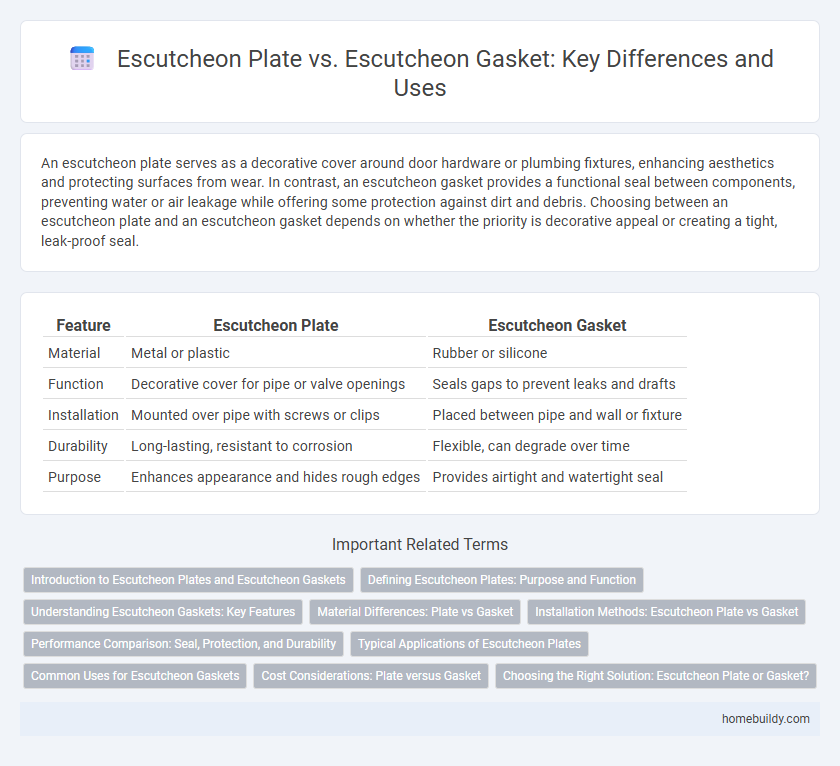An escutcheon plate serves as a decorative cover around door hardware or plumbing fixtures, enhancing aesthetics and protecting surfaces from wear. In contrast, an escutcheon gasket provides a functional seal between components, preventing water or air leakage while offering some protection against dirt and debris. Choosing between an escutcheon plate and an escutcheon gasket depends on whether the priority is decorative appeal or creating a tight, leak-proof seal.
Table of Comparison
| Feature | Escutcheon Plate | Escutcheon Gasket |
|---|---|---|
| Material | Metal or plastic | Rubber or silicone |
| Function | Decorative cover for pipe or valve openings | Seals gaps to prevent leaks and drafts |
| Installation | Mounted over pipe with screws or clips | Placed between pipe and wall or fixture |
| Durability | Long-lasting, resistant to corrosion | Flexible, can degrade over time |
| Purpose | Enhances appearance and hides rough edges | Provides airtight and watertight seal |
Introduction to Escutcheon Plates and Escutcheon Gaskets
Escutcheon plates serve as decorative or protective covers around plumbing fixtures or locks, enhancing both aesthetics and functionality by concealing rough edges or holes. Escutcheon gaskets, on the other hand, are specialized sealing components placed behind or within escutcheon plates to prevent water leaks and ensure a tight fit. While escutcheon plates focus on outward appearance and structural coverage, escutcheon gaskets prioritize waterproofing and secure installation in plumbing and hardware applications.
Defining Escutcheon Plates: Purpose and Function
Escutcheon plates serve as protective and decorative covers that conceal gaps or holes around door hardware, enhancing aesthetic appeal and preventing dirt or moisture intrusion. Unlike escutcheon gaskets, which function primarily as sealing components to improve airtightness and soundproofing, escutcheon plates focus on structural protection and visual finishing. Their design supports hardware stability while reinforcing the door surface against wear and environmental damage.
Understanding Escutcheon Gaskets: Key Features
Escutcheon gaskets provide a watertight seal between the escutcheon plate and the wall, preventing moisture infiltration and protecting underlying structures from damage. Unlike escutcheon plates, which primarily serve decorative and protective purposes by covering pipe penetrations, gaskets enhance the installation's durability through their flexible, compressible material. Key features of escutcheon gaskets include their resistance to mold, ability to accommodate uneven surfaces, and compatibility with various plumbing fittings.
Material Differences: Plate vs Gasket
Escutcheon plates are typically made from durable metals such as stainless steel, brass, or chrome-plated alloys, providing rigid protection and an aesthetic finish around plumbing fixtures. In contrast, escutcheon gaskets are generally composed of flexible materials like rubber, silicone, or neoprene, designed to create a watertight seal between the fixture and mounting surface. The material differences impact functionality, with plates offering structural coverage and gaskets delivering leak prevention through their compressible properties.
Installation Methods: Escutcheon Plate vs Gasket
Escutcheon plates are typically installed by securing them over pipe openings with screws or adhesive, providing a decorative and protective cover that enhances wall aesthetics. In contrast, escutcheon gaskets are placed directly around pipes before the plate, creating a tight seal to prevent water leakage and reduce vibration. The installation of escutcheon gaskets focuses on functionality, while escutcheon plates prioritize both appearance and securing the pipe entry point.
Performance Comparison: Seal, Protection, and Durability
Escutcheon plates provide a durable, aesthetic cover for plumbing fixtures, enhancing protection against external damage and corrosion, while escutcheon gaskets focus primarily on creating a watertight seal to prevent leaks. In terms of sealing performance, escutcheon gaskets offer superior leak prevention due to their flexible material, which conforms closely to surfaces, whereas escutcheon plates offer limited sealing ability but excel in surface protection and durability. Durability-wise, escutcheon plates typically withstand physical impacts and environmental wear better than gaskets, making them ideal for long-term structural protection, while gaskets require periodic replacement to maintain optimal sealing.
Typical Applications of Escutcheon Plates
Escutcheon plates are commonly used in plumbing and door hardware to provide decorative and protective covers around pipe penetrations or lock cylinders, enhancing aesthetic appeal and preventing dirt or moisture ingress. Unlike escutcheon gaskets, which primarily serve as sealing components, escutcheon plates focus on surface finishing and concealment in residential, commercial, and industrial settings. Typical applications include bathroom shower installations, sink plumbing, and door lock assemblies where visual clean lines and durability are crucial.
Common Uses for Escutcheon Gaskets
Escutcheon gaskets are commonly used to create a watertight seal between escutcheon plates and plumbing fixtures, preventing leaks and protecting wall surfaces from moisture damage. They are essential in bathroom and kitchen installations, especially around faucets and shower valves, where water exposure is frequent. Unlike escutcheon plates, which primarily provide a decorative cover, escutcheon gaskets serve a crucial functional role by enhancing the durability and integrity of plumbing assemblies.
Cost Considerations: Plate versus Gasket
Escutcheon plates typically incur a higher initial cost due to their durable metal or decorative finishes, while escutcheon gaskets are generally more affordable as they consist of flexible rubber or silicone materials. Maintenance expenses for plates might increase over time because of potential corrosion or cosmetic wear, whereas gaskets often require more frequent replacement but at a lower individual cost. Budget planning should weigh the long-term durability of escutcheon plates against the cheaper, though more frequently replaced, escutcheon gaskets.
Choosing the Right Solution: Escutcheon Plate or Gasket?
Choosing between an escutcheon plate and an escutcheon gasket depends on the specific application and desired finish. Escutcheon plates provide a decorative and protective cover for pipe penetrations, ideal for visible installations where aesthetics matter. Escutcheon gaskets, made from flexible materials like rubber or foam, offer superior sealing against drafts, moisture, and dust, making them suitable for maintaining airtightness behind walls or ceilings.
escutcheon plate vs escutcheon gasket Infographic

 homebuildy.com
homebuildy.com